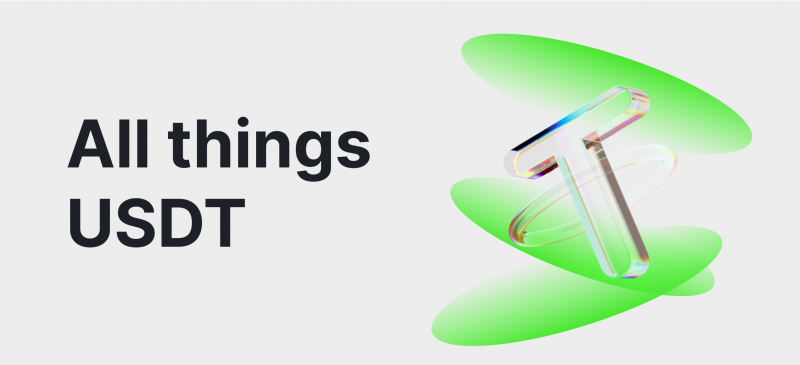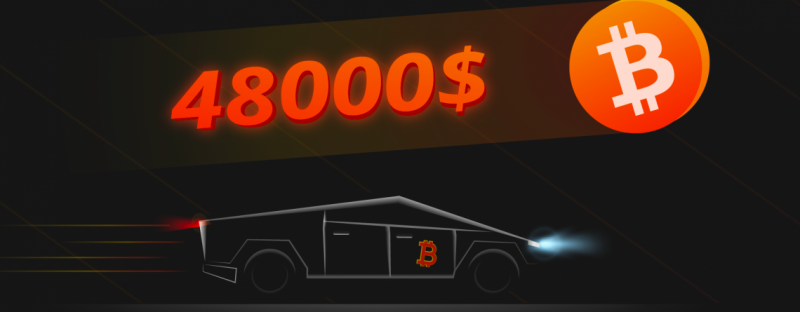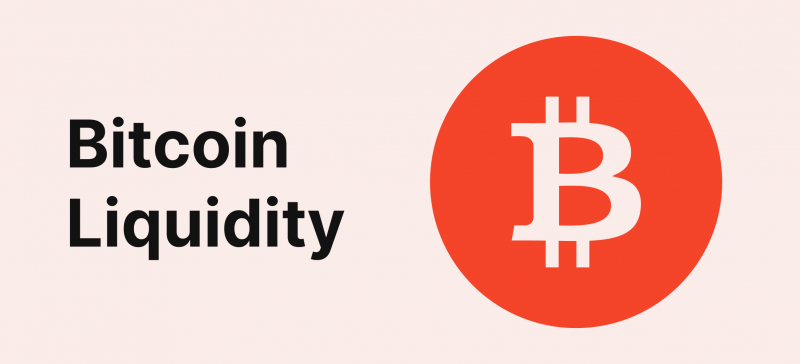Currently, Ethereum ranks second in terms of market capitalization. Aside from being a subject of investment, it is also being applied in various directions for enhancing the use of blockchain technology, resulting in an ecosystem on which new crypto projects are developed that contribute to the development of the crypto industry. With great value and wide practical application, the Ethereum shared ledger is constantly improving and undergoing changes, which are the result of a deep informational modernization of blockchain protocols called scalability.
This article will guide you through the world of Ethereum, explaining what Ethereum scalability is and why it is needed. You will also learn what solutions are used in the Ethereum blockchain scaling process and how they work. In the end, you will understand why the rollup-centric Ethereum roadmap is the future of this blockchain project.
Key Takeaways
- The Ethereum project has experienced more than 10 hard forks in its history in an attempt to bring the blockchain to optimal functioning.
- There are two types of network scaling – vertical and horizontal. In the first case, the bandwidth of the block is improved or degraded, in the second case, the number of resources is increased, and the load is distributed among them.
- Tier 2 solutions are designed to make more efficient use of the Ethereum ledger by increasing the speed and number of transactions and reducing gas charges.
What is Ethereum Scaling and Why is it Necessary?
Scalability is the software ability of a blockchain to balance supply and demand, expressed as the ability of a network or database to increase its performance under overload conditions. There is vertical (by improving the hardware) and horizontal (by distributing the load evenly over small segments) scaling of the system. The first is realized by increasing the capacity of central nodes, and the second is by software methods.
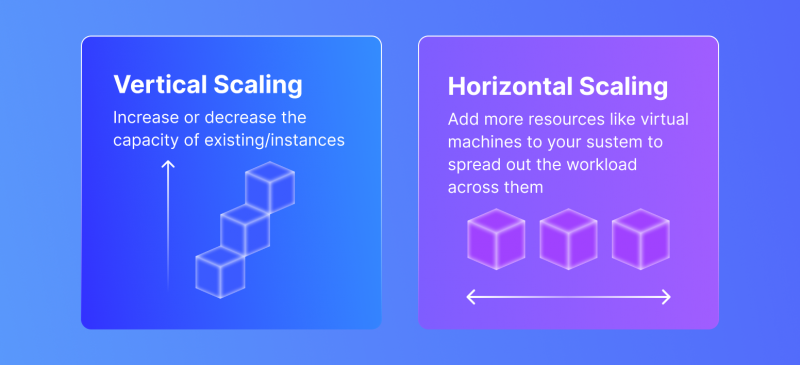
After Ethereum, as well as other cryptocurrencies, ceased to be a marginal payment instrument and became ubiquitous, the load on its blockchain increased manifold. As a result, many negative factors were holding back the protocol’s development, from huge transaction fees to extremely poor scalability, compared to other blockchains using Layer 1 scaling solutions.
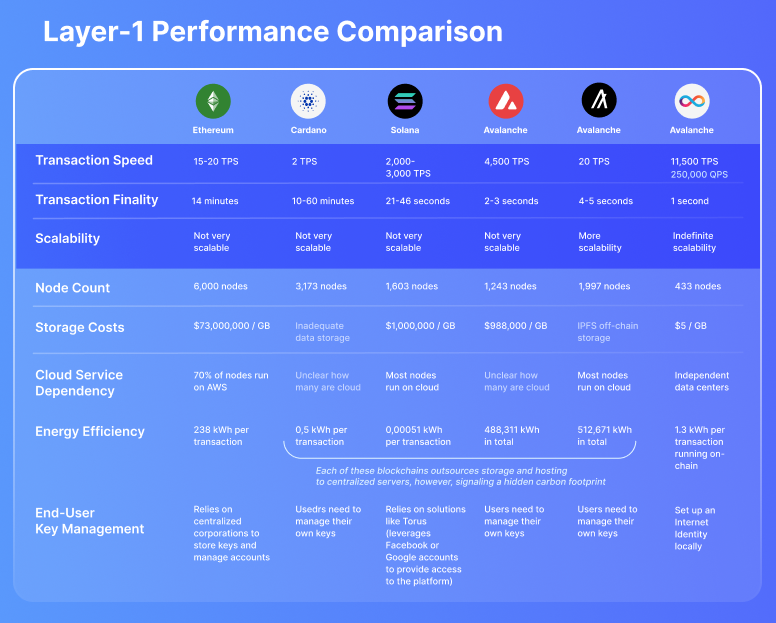
Throughout its existence, Ethereum vision has already undergone six “hard” updates that have led to significant changes to its blockchain. These events are called hard forks, and they are branching networks where all users have to switch to a new version of the software that has been improved by the developers. This is what happened with each of the preconceived air updates. But there were also unscheduled Ethereum hard forks conducted due to hacker attacks. A list of the most significant updates to the network is given below:
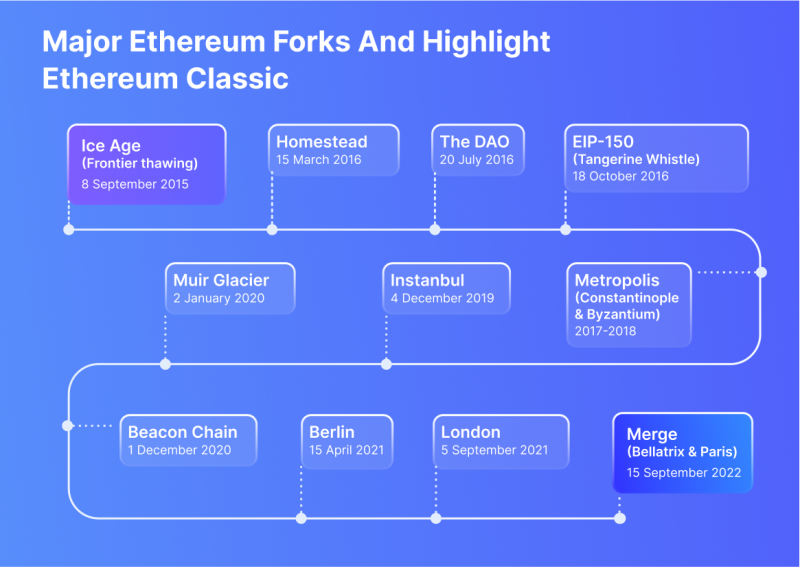
1. Ice Age (Frontier thawing) – 8 Sep 2015
This is an unscheduled hard fork, which was carried out to increase the security and speed of blockchain updates.
2. Homestead – 15 Mar 2016
The main goal of this fork was to eliminate centralization. Transactions with the network’s cryptocurrency (ETH) became available to network users, who could also deploy smart contracts. After that, Ethereum became a full-fledged DeFi project. Many users learned about its native coin and invested in ETH; Ether trading began gaining momentum in the crypto community.
3. The DAO – 20 Jul 2016
The DAO fork was in response to the 2016 DAO attack, where an insecure DAO contract was drained of over 3.6 million ETH in a hack. The fork moved the funds from the faulty contract to a new contract with a single function: withdraw.
4. EIP-150 (Tangerine Whistle) – 18 Oct 2016
This hard fork has changed the cost of gas for transactions. This update was meant to help eliminate the DDoS attack capabilities that the main Ethereum chain suffered from at this point, or at least make them much more costly for attackers.
5. Metropolis (Constantinople & Byzantium) – 2017 – 2018
This two-part hard fork of the Ethereum ecosystem, planned by the developers, was aimed at preparing the network for the transition to the Proof-of-Stake (PoS) mining algorithm and the implementation of solutions to scale the network.
Thanks to the Constantinople fork, Ethereum became faster, more efficient and more convenient. Smart contracts have become easier to develop, and certain operations in the Ethereum code have been simplified.
6. Instanbul – 4 Dec 2019
This significant blockchain update included 6 suggestions to improve Ethereum, including increasing the cryptocurrency’s scalability, ensuring compatibility with Zcash coin, changing the gas price for different transaction codes, and increasing the system’s resistance to DDoS attacks.
7. Muir Glacier – 2 Jan 2020
Fork Istanbul was not wholly successful; less than half of the nodes had installed the necessary software by the time of the update, block mining time began to grow, and on January 2, 2020, Ethereum network held another fork Muir Glacier, whose primary purpose was to delay the “complexity bomb” once again.
8. Beacon Chain – 1 Dec 2020
The Beacon Chain stage features the long-awaited launch of the new Proof-of-Stake ledger and additional changes such as sharding, inter-segment communication, and the transition from the Ethereum Virtual Machine (EVM) to the WebAssembly (eWASM).
9. Berlin – 15 Apr 2021
This hard fork is essentially the second stage of Istanbul and preparation for the London fork and included improvements such as reduced fees, use of different types of transactions, faster transaction throughput, and support for new types of trades.
10. London – 5 Sep 2021
This update included five changes, the most controversial of which is EIP-1559. It changed the mechanism for calculating rewards for miners for mining a block. Part of the rewards were now to be burned. This method is used to combat cryptocurrency inflation. Although miners would now receive less for mining blocks, theoretically, they should benefit by increasing the value of cryptocurrency.
11. Merge (Bellatrix и Paris) – 15 Sep 2022
This update of ethereum scaling represents a formal move to consensus proof-of-ownership. This eliminates the need for energy-intensive mining and instead protects the network with delivered ether. Such an update was a historically important step in realizing Ethereum’s vision of greater scalability, security, and resilience.
Ethereum Blockchain Scaling Solutions: Types and Principle of Operation
The history of the evolution of the second most popular crypto coin on the market, Ethereum, is a long process of changing the philosophy of the project and the principles of its functioning. As a distributed ledger network, Ethereum is a complex algorithm system that operates using different solutions to scale Ethereum. Let’s consider the main types of such solutions to better understand what it is about.
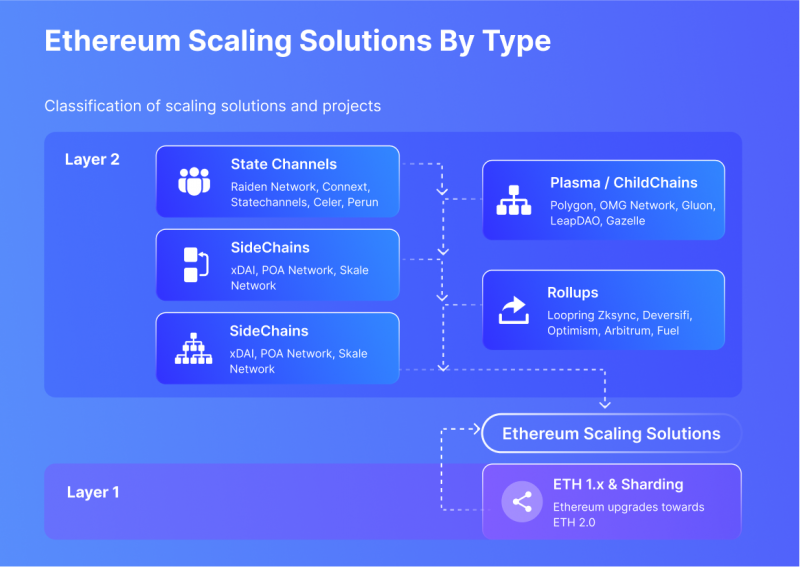
On-Chain/Layer 1 Scaling
Because blockchain is an open network system, anyone has the right to act as a node to participate in the accounting. Formulating a set of rules that all nodes must abide by is a very important issue in order for the blockchain to run smoothly.
Layer 1 solutions are the standard basic consensus layer on which almost all Ethereum’s ledger network transactions are currently performed. The concept of layers is not specific to Ethereum. Its design allows the blockchain to maintain “ledger” and “transaction finality” state consistency, so that nodes can transact data in an unauthorized manner and achieve consensus in an encrypted fashion without centralized control. Sharding is currently the main focus for this method of scaling.
Sharding
Sharding is a scaling technique for handling data. Its essence is to divide (partition) the database into separate parts to move each to a separate server.
The concept of sharding is to divide the network into several sections that can operate partially independently. Section A deals with several transactions, and section B deals with another group of transactions. This mechanism doubles the number of transactions that can be executed, given that the limit is now determined by the bandwidth of two nodes simultaneously.
By splitting the blockchain into different sections, the number of potentially processed transactions can be increased linearly. Implementing the sharding solution works on the first layer of the network. Therefore, branching will need to be done to update the network protocol and implement this solution for scalability.
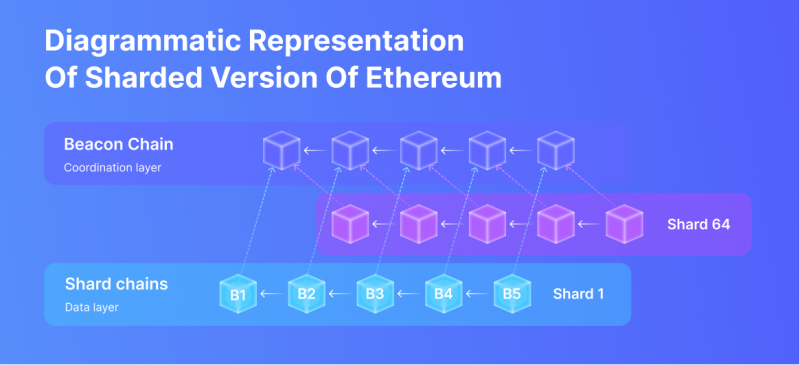
Off-Chain/Layer 2 Scaling
Layer 2 solutions are infrastructure Eth2 solutions in the form of applications and different software built on top of underlying blockchains. They can handle large transaction volumes and reduce the load on the underlying network. There are now several options for second-tier solutions: sidechains, state channels, and optimistic and ZK rollups. Layer 2 solutions are designed to circumvent the limitations of scalability, isolation, and low flexibility for developers.
Layer 2 scalability solutions include a whole list of technologies that aim at comprehensive development of Ethereum blockchain. Let’s look at each of them in more detail.
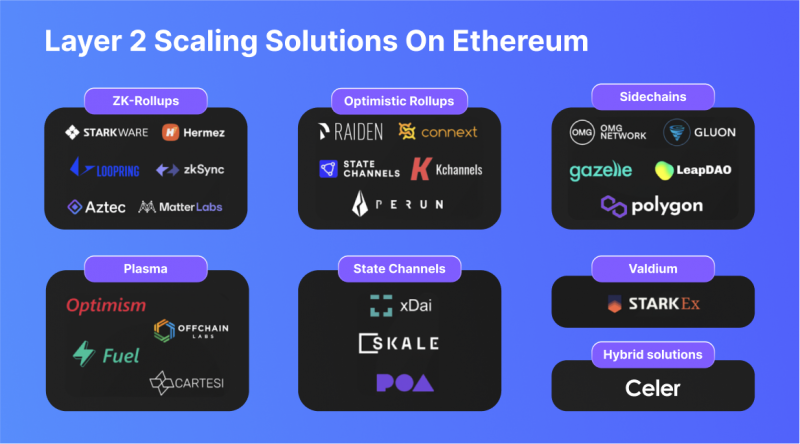
Rollups
Rollups perform Layer 2 transactions and send data to the underlying blockchain. This means they get a layer of security from Ethereum, but can perform transactions outside of it. There are two types of rollups. The first is ZK (Zero Knowledge), which combines multiple transfers into a single transaction. The second type is optimistic rollups, which work in parallel with Ethereum.
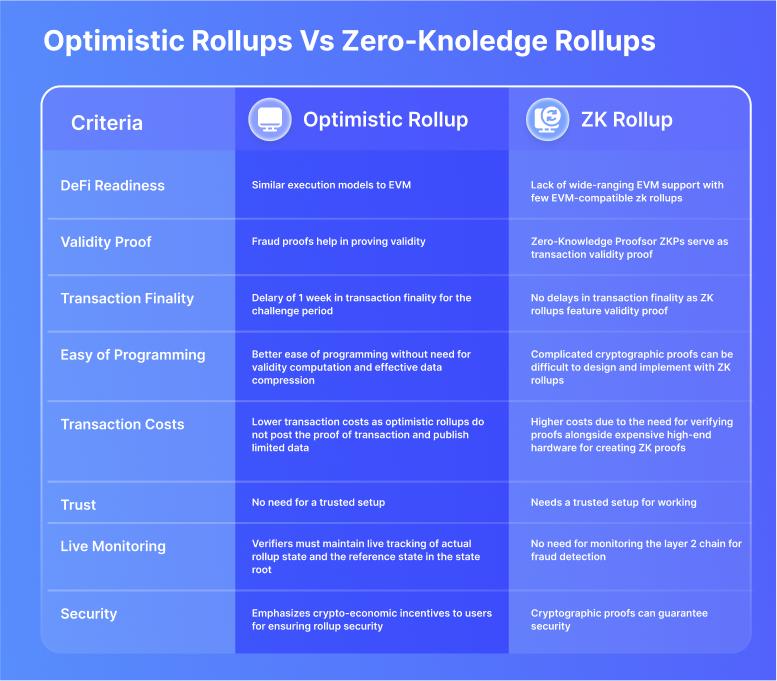
a) Zero Knowledge Rollups
ZK rollup (Zero-Knowledge rollup) is a blockchain scaling Ethereum technological solution that uses Zero-Knowledge Proof of Concept protocols to ensure transaction data privacy and security. In ZK rollup, multiple transactions are compressed into a single block, which is then sent to the main blockchain for validation.
Zero-Knowledge Proof protocols are used to prove that a transaction is valid without having to disclose the details of the transaction itself. This allows participants in the network to verify the transaction without exchanging any information other than proof of validity. This makes the ZK rollup a secure and confidential way to scale the blockchain.
Zero-Knowledge Proof can be of two types – interactive and non-interactive, which are called ZK-Stark and ZK-Snark, which have their own features.
ZK-Stark
ZK-Stark, or the scalable transparent knowledge argument with zero disclosure, is essentially a “cousin” of ZK-Snark, only better. ZK-Stark eliminates one of ZK-Snark’s major weaknesses: its dependence on trusted configuration. For the ZK-Snark protocol, this is a prerequisite, while ZK-Stark does not require such a phase. Instead, ZK-Stark relies on simpler cryptographic assumptions.
ZK-Snark
Zk-Snark is the more popular of the two main types of zero-knowledge proofs. Several projects in the crypto space today use them to improve Ethereum’s scalability and privacy. This knowledge argument quickly generates and verifies zKp; privacy-enhancing protocols use them extensively. With Zk-Snark, privacy-enabled blockchain can hide transactions from prying eyes, allowing users to provide zero-knowledge evidence instead of normal transaction records.
b) Optimistic Rollups
The basic idea of fraud-proof is to send a minimum of data to layer 1 and assume (optimistically) that it’s true. To prevent attackers from spamming the network, senders must also provide a deposit (usually in ETH), which will be withdrawn if the blockchain detects fraud. One of the main projects working on optimistic rollups is Optimism.
State Channels
A state channel is a solution that allows users to create their own channel outside of the blockchain where they can conduct unlimited private transactions. The blockchain only stores the first and last transactions. The first transaction opens the channel; participants must lock funds into a multi-signature contract. The connection is closed with the second transaction. When all transactions between participants are completed, the network’s final transaction is sent, and funds are unlocked. All transactions in the channels are only visible to their respective users. The blockchain only records the initial and final states.
Sidechains
Sidechains operate separately from the main blockchain and act independently, using their own consensus algorithm. They connect to Ethereum via a two-way bridge (crosschain). Sidechains are compatible with the Ethereum Virtual Machine, but have limitations: they are less decentralized than the main network. In addition, the consensus algorithm is not governed by Layer 1, and sideline validators can coordinate for criminal purposes.
Plasma Chain
Plasma is a Layer 2 scaling solution originally proposed by Joseph Poon and Vitalik Buterin. It is a platform for creating scalable applications on Ethereum. Plasma uses smart contracts and Merkle trees to create an unlimited number of child chains – copies of the parent Ethereum digital ledger.
Validium Chain
Validium is a scaling solution that uses validity proofs but has off-chain data availability. It compromises Ethereum’s security but is still much more secure than sidechain because transitions between states are validated using STARK / SNARK. Validium is similar to ZK rollup technology in that it uses zero-disclosure evidence. But the data is stored offline. This yields up to 10,000 transactions per second with no withdrawal delays and less attack risk.
On the morning of September 15, 2022, The Merge update occurred on the ETH network. As a result, the crypto currency switched from Proof-of-Work (PoW) to Proof-of-Stake (PoS).
Rollup-Centric Ethereum Roadmap: The Future of the Ethereum Scaling
Financial sustainability is a fundamental requirement of a crypto project, and in 2023 this could mean millions, if not tens of millions, of dollars in funding. The Ethereum Foundation or Gitcoin Grants can provide some funding for some of these projects, but their scale is just not sufficient to cover such a substantial amount. In some cases, layer 2 projects can launch their own tokens – provided, of course, the tokens are backed by genuine economic value (i.e., fees predicted for the future).
In addition to the above benefits, a roll-up-centric roadmap also leaves space for L2 protocols, which are capable of collecting fees/MEV that can be used to fund development, either directly or indirectly (by backing a token that does so). Because Ethereum’s base layer must be credibly neutral, it is difficult for in-protocol funding of public goods to take place (consider the ACD call trying to determine how much each person should receive). However, L2s having their own public goods funding mechanisms (and/or contributing to Gitcoin Grants) is less contentious. It may therefore be beneficial for Ethereum’s long-term economic sustainability if we leave this space open.
Aside from funding issues, those who are most creative often desire to be able to have a great deal of influence on their own little island, as opposed to being able to argue with others on the future of the Ethereum protocol as a whole. Moreover, there are a number of existing projects that are seeking to develop various types of platforms. Rollup-centric roadmaps provide a clear path for all of these projects to become part of the Ethereum ecosystem while maintaining a high degree of autonomy from the Ethereum ecosystem in terms of economics and technical considerations.
Ethereum scaling has undoubtedly been one of the hottest topics in recent months. The network’s transition to the Proof-of-Stake consensus algorithm in September 2022 was an important milestone in this regard, as it opened the door to implementing many scaling solutions. While ETH developers are working on the natural scaling of the network, the power of layer 2 solutions is just beginning to emerge. Concepts such as zero-disclosure proofs are now becoming a reality, but they are still very foreign to many.
Conclusion
The use of rollups in the future of Ethereum update will play an indispensable role in ensuring the stability of the blockchain and its comprehensive development, compared to first-tier solutions such as sharding. According to project creator Vitalik Buterin, the solution will fundamentally transform its ledger infrastructure to enable the expansion of its practical application in the crypto industry.


